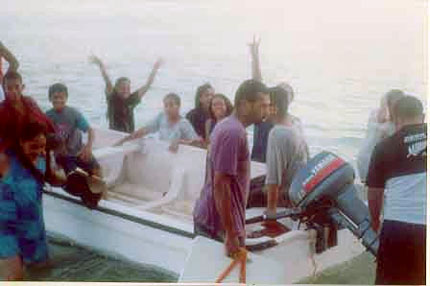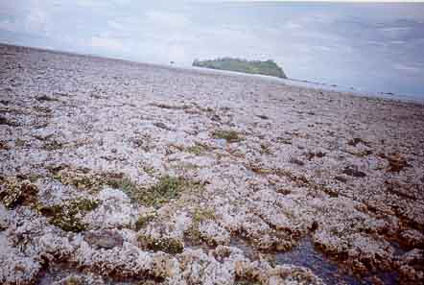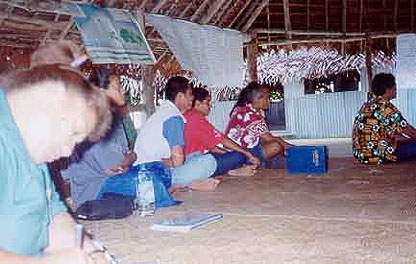|
||||||||
|
Why the kama (rough coral) overgrowth? Is it the dumping of cans and other rubbish on the beaches over the years that caused it? LäjeRotuma's response: It has yet to be determined what species of coral is forming the kama. It seems fast growing. The team is here on a fact-finding mission and time is needed to verify details. Irresponsible dumping of non-biodegradable items to the beach front doesn't help the problem. Who does LäjeRotuma represent? Is it the Council? Government? Or some NGO? LäjeRotuma's response: None of the above. This initiative was undertaken by young Rotumans living away from home who hope to contribute to and enhance the island residents' understanding of their island environment. How will survey of the kama be done? LäjeRotuma's response: The scientific survey of the kama is still in planning. The purpose of this first trip, and a few more to come this year, is to gather information from the community about their own resource knowledge; this, combined with baseline data collected, will inform the scientific phase of the project that is planned for 2003. The crown of thorns (COTS) was mentioned. LäjeRotuma's response: COTS is a reef killer. We asked if people saw this organism quite often when out fishing. We warned those attending the meeting not to cut them up because of their ability to regenerate; it doesn't help reduce the numbers. We were told that the COTS size is quite large and tht they are usually found on the outer barrier reef. We were also told that octopus is rarely found on the reef now.
The first signs of kama occurred after Hurricane Bebe. The dumping of rusting cans on the beach was also a suspect (it seems that some view kama as something 'dead, yet alive'; the majority suggested that the rust in cans causes kama to grow). What about the fish? Shouldn't LäjeRotuma study fish, because that is what we eat. LäjeRotuma's response: LäjeRotuma isn't here to study just the coral. In fact, the team is here initially to train youth leaders to assist LäjeRotuma with its activities within their own communities. Its mission is to gather information from the community along with baseline data, which in combination will be used to develop a plan for the study of the coral reefs. Kama is a significant part of the study, but the whole island-associated-reef ecosystem will be included. Do you consider safety? Will LäjeRotuma be diving in Rotuma? LäjeRotuma's response: Yes, it is the first priority. We hope that in time there would be some diving done to really assess the depths. Issues such as a recompression chamber, tanking, and costs have yet to be addressed. What does the coral eat? How do they live?
Theories contributing to kama:
An elder hoped that LäjeRotuma would assist in the removal of COTS by funding a removal project. However, it was noted that COTS removal would tip the natural balance of the ecosystem. An elder also mentioned the carpet-like growth that makes the kama slippery to walk on. He also mentioned that this growth could block the coral polyps from feeding. The team did a reef walk and noticed the kama covered most of the reef. A seawall (170m) has been built to slow longshore erosion. Very low diversity on the reef. Suggested causes:
Issues:
Juju District Issues raised:
Why does the kama grow so fast? Should we remove it by dynamiting? LäjeRotuma's response: Kama is a fast growing coral species that regenerates when broken up, thus adding to the already plentiful kama in the area. There must be an assessment study of the whole coral reef before any decision involving dynamiting takes place. A male student (F5) suggested that the herbicides used up at the plantations seeps through the soil and moves downstream to the coastline, eventually entering the sea and killing the coral! LäjeRotuma's response: There is need for an assessment of herbicides in use on the island. There is the water table and the soil type to consider before we can understand what causes the overgrowth of kama or the overall sorry condition of the reefs. One man expressed the belief that coral builds islands, so the extensive growth of kama is indeed a good thing because it builds the land. An example he gave was the isthmus in Motusa. Many years ago the two ends of the island were separated, but over time sand accumulated over the dead coral and eventually a strip of land developed where the village hall is situated! Of course, the inshore fishing is affected but the overgrowth of kama also has brought the fishing ground closer to the barrier reef, which is much nearer now. So there is now an alternative to deep-sea fishing at a closer distance than before. Students asked : How are islands formed? What type of island is Rotuma? Note: Itu'muta and Malhaha Districts were not visited by the team due to lack of coordination with its representatives. LäjeRotuma looks forward to the next Youth Outreach Program Trip. |
||||||||






